Apr 13, 2025
Apr 13, 2025
by Shiloh
As a western Buddhist on pilgrimage in the Ganges basin, one of the most startling discoveries was the complete absence of Indian Buddhist communities. Every Indian town, even the humblest village, has dozens of shrines dedicated to Hindu deities and at least one major and various minor temples where people worship every day. Most urban skylines also feature the rounded domes and minarets of Islamic mosques. But outside of the eight great places of pilgrimage, Buddhist temples are virtually unheard of in most parts of India.
As Khenchen Palden pointed out in his speech at the dedication ceremony for Padma Samye Ch'khor Ling, there are many people in India who have never heard of the Buddha and know nothing about his teaching. All of the major pilgrimage sites are surrounded by booths selling malas, incense and cheap statuary, as well as the typical contingent of food stalls offering chai tea, somosas, rice and dahl. The salesmen are inevitably non-Buddhist. So are the beggars. Buddhism is something of a relic in the very land where it originated.
Eight sites in northern India host the original stupas containing the Buddha's remains. Since 1949, these places have been designated and protected as national treasures. Ironically, to most Indians, the real treasure associated with these sites comes in the form of the tourist dollar, while the spiritual resonance of the presence of the Buddha merely serves as a strange attractor. Rarely will you enter one of these sanctuaries unaccompanied by a self-made tour guide who will insist on practicing his English on you, overriding all your attempts to have a quiet, meditative experience... and then charge you for the intrusion... Outside of the busloads of Theravada pilgrims from southern India, I did not meet one Indian Buddhist in the month that I spent wandering through across the Gangetic plain. The major Buddhist sites sport a few handfuls of foreign monks maintaining small monasteries built and supported by Buddhists in other countries such as Sri Lanka, Thailand, Burma, Tibet, China, Japan and Korea. In spite of the fact that the Buddha wandered and taught throughout this area 2500 years ago and that Buddhism has long since become one of the world's major religions, most of the present Buddhist institutions in India have been established within the last fifty years. Since the wave of Muslim conquest swept across northern India in the early thirteenth century, Buddhism has effectively disappeared from its original homeland in the Ganges basin. Fortunately, long before the final wave of conquest effaced the Dharma from India, it had already found more fertile ground in both Tibet, China and Sri Lanka as well as in other countries of eastern Asia where it has been preserved for the last 800 years in living traditions.
Gaya
Long ago, there lived an asura named Gayasur who performed great penances in the Kolahala Mountains. As a result, Vishnu blessed him so that whoever touched his body would go to heaven then and there. As the hells began to empty, Yama complained to the council of Gods, and Brahma agreed to ask the ascetic for his body to perform a yajna sacrifice. Gayasur was devoted and readily submitted but even this did not kill him.
Yama carried a special rock which had once been his daughter. She had married Brahma's son Maricha who got terribly jealous one evening and turned the poor girl to stone. She asked Lord Vishnu for help, but was told she would never be able to regain her form. Instead, Lord Vishnu granted her second request, that all with whom she came into contact would be liberated from Samsara.
Yama placed this holy stone on the body of Gayasur who yet continued to move beneath it. Finally, Vishnu and his retinue arrived. The Lord stood upon the asura and in recognition of his devotion, granted him a final boon. The big fellow calmly said, 'Lord, may the place where I die be turned to stone supporting the feet of Lord Vishnu and all the other gods. May it be known by my name and become famous throughout the world. May the ancestors of those who come here and offer sweet cakes over my body, be freed of all sins. May this place remain as long as the earth, the sun, and the moon exist.' As he died, his boon was granted and he immediately turned to stone.
Lord Vishnu named the place Gaya Kshetra and his footprint is enshrined within a black stone temple. An octagonal basin, four feet in diameter, sunk into the marble floor and plated with silver surrounds the magical impression of Vishnu's foot. The Vishnupada itself is about sixteen inches long and six inches wide. The Lord had big Feet.
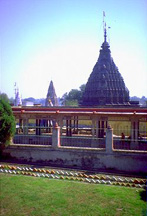 During the winter of 1835, a sixty year old Hindu pilgrim by the name of Khudiram Chaottopadhyaya stayed in Gaya for about a month, making offerings and worshipping at over forty-five places by the streams and on the hills surrounding the town. Having fulfilled his obligation to his ancestors, he felt an overwhelming gratitude to the Divine Lord who made it possible for a poor, unworthy man like himself to be able to accomplish all this. That night he had a dream in which he saw his ancestors in celestial bodies, graciously accepting the sweet cakes he had offered. Overcome with emotion, he bowed and touched their feet. Suddenly the space was filled with a great light. His forefathers stood reverently worshipping, their hands folded, on either side of an extraordinary Being in a luminous green body, seated happily on a great throne. Khudiram approached and prostrated before the Being. Pleased by his worship, the Great One told Khudiram he would soon take birth as his son. Upon returning to his home in the village of Kamarpakur, Khudiram's wife related an experience wherein she had been overcome by a brilliant light shining out of the local Shiva temple. Chandra Devi was pregnant with the child who was to become Sri Ramakrishna.
During the winter of 1835, a sixty year old Hindu pilgrim by the name of Khudiram Chaottopadhyaya stayed in Gaya for about a month, making offerings and worshipping at over forty-five places by the streams and on the hills surrounding the town. Having fulfilled his obligation to his ancestors, he felt an overwhelming gratitude to the Divine Lord who made it possible for a poor, unworthy man like himself to be able to accomplish all this. That night he had a dream in which he saw his ancestors in celestial bodies, graciously accepting the sweet cakes he had offered. Overcome with emotion, he bowed and touched their feet. Suddenly the space was filled with a great light. His forefathers stood reverently worshipping, their hands folded, on either side of an extraordinary Being in a luminous green body, seated happily on a great throne. Khudiram approached and prostrated before the Being. Pleased by his worship, the Great One told Khudiram he would soon take birth as his son. Upon returning to his home in the village of Kamarpakur, Khudiram's wife related an experience wherein she had been overcome by a brilliant light shining out of the local Shiva temple. Chandra Devi was pregnant with the child who was to become Sri Ramakrishna.
Several months after his Awakening, the Buddha delivered a sermon to an audience of 1,000 fire-worshipping ascetics on a local hill called Gaya Head, which is identified with the head of the great asura. Here, the Buddha utilized imagery that quickly penetrates to the heart of the audience -- in this case, the metaphor of fire. Upon hearing this talk, the entire audience realized arhathood.
Vishnupada Temple at Gaya. The open pavilion with the red roof in the foreground
is a shelter for poor pilgrims and possibly where Khudiram stayed during his visit here.
Moving through the dark on steel rails, I attached myself to my bags and fell asleep. A few hours later, I awoke as the train was moving slowly through a dimly lit station. I looked up at the man across from me and asked, 'Gaya?' He nodded and smiled, pointing out the window. As the train was starting to pick up speed, he helped me drag my bags toward the door where I quickly thanked him, kicked them off, and jumped out onto the platform. It is near midnight as I drag them out of the station past the cabs, and across the plaza to the nearest hotel. After securing a room, I hit the streets looking for something to eat, but apparently far too late to expect anything like dinner in Gaya. Settling for some coconut sweets and a soda, I head back to my room and put on santosh music, and read a few selections from Padma Karpo (whom Guenther has dubbed the Kagyu Longchenpa).
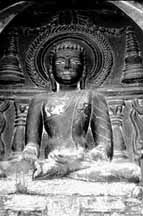 In the morning I am off via bicycle rickshaw to the Vishnupada temple in Gaya, one of the main holy places for devotees of Lord Vishnu. Having read in the guide book that they have recently begun allowing white tourists in, I hang around the entrance and inquire, but today does not seem to be favorable. I wander down to the bathing ghat which leads out onto the sandy bed of the Phalgu River. Noting the huge stacks of firewood, I come upon a small gathering tending a funeral pyre. Another corpse enshrouded in saffron colored cloth awaits cremation on the side. I wander around outside the temple, relax in the shade of the guest shelter, take pictures, buy a few small copper replicas of the holy impression and am finally approached by an older teenager who knows I am interested in getting inside. He leads me around into an alley not far from the main entrance where we enter his family's shop. Motioning me to the back, we climb a ladder of stairs into an upper room used for storage. Amid crates of soap and soda, he opens a small door and suddenly I am looking directly into the shadowy cool of the main temple. The octagonal frame surrounding the Footprint was visible. A few heads turned in surprise and although he insists there would be no problem, I am sure this is not the proper way to enter; I simply smiled at the people we had interrupted and asked the boy to shut the door.
In the morning I am off via bicycle rickshaw to the Vishnupada temple in Gaya, one of the main holy places for devotees of Lord Vishnu. Having read in the guide book that they have recently begun allowing white tourists in, I hang around the entrance and inquire, but today does not seem to be favorable. I wander down to the bathing ghat which leads out onto the sandy bed of the Phalgu River. Noting the huge stacks of firewood, I come upon a small gathering tending a funeral pyre. Another corpse enshrouded in saffron colored cloth awaits cremation on the side. I wander around outside the temple, relax in the shade of the guest shelter, take pictures, buy a few small copper replicas of the holy impression and am finally approached by an older teenager who knows I am interested in getting inside. He leads me around into an alley not far from the main entrance where we enter his family's shop. Motioning me to the back, we climb a ladder of stairs into an upper room used for storage. Amid crates of soap and soda, he opens a small door and suddenly I am looking directly into the shadowy cool of the main temple. The octagonal frame surrounding the Footprint was visible. A few heads turned in surprise and although he insists there would be no problem, I am sure this is not the proper way to enter; I simply smiled at the people we had interrupted and asked the boy to shut the door.
Bodhgaya
In the dry season, the River Phalgu is reduced to a thin stream meandering across a wide sandy plain which is completely inundated during the monsoons. Known as the Nairanjana River in the days of the Buddha, it was along these banks that Gautama accepted a bowl of curds from the maiden Sujata and applied his re-acquired strength to the night of meditation which would culminate in his awakening.
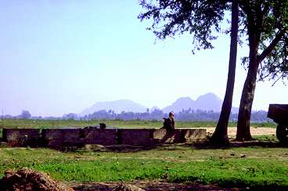 I walked into town to buy some twine. I needed some to send a package. The shopkeeper knew English and offered me grapes. It was midday and the heat was coming on as he motioned me into his shop. I followed him up a few flights of stairs. Soon we were sitting in the open air up on the third floor of a small brick building near the central market, gazing through the unfinished wall over the temporary desert of the Phalgu to a rocky hill where Shakyamuni spent six years doing ascetic practices; Mount Pragbodhi. Tradition has it that the Buddha considered several sites on this mountain as the possible place of enlightenment, but each time the earth quaked, so he decided to move about four miles southwest into a shady grove on the far side of the river.
I walked into town to buy some twine. I needed some to send a package. The shopkeeper knew English and offered me grapes. It was midday and the heat was coming on as he motioned me into his shop. I followed him up a few flights of stairs. Soon we were sitting in the open air up on the third floor of a small brick building near the central market, gazing through the unfinished wall over the temporary desert of the Phalgu to a rocky hill where Shakyamuni spent six years doing ascetic practices; Mount Pragbodhi. Tradition has it that the Buddha considered several sites on this mountain as the possible place of enlightenment, but each time the earth quaked, so he decided to move about four miles southwest into a shady grove on the far side of the river.
Looking eastward at the mass of Mount Pragbodhi where Shakyamuni did ascetic practices for six years. On the western side of the Mahabodhi stupa is The Vajrasana or Diamond throne with offerings under a canopy of gold.
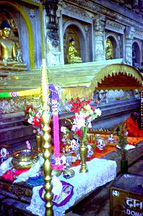 In all the world, only one place -- the Vajrasana, the Diamond Throne, the only place firmly rooted to the core of our world-system-could withstand the energies released through the transformative event of a Buddha's enlightenment. While the descriptions in the Abhidharmakosa-bhasya link the Vajrasana solidly to earth, within the Mahayana traditions the Vajrasana relates to a more comprehensive vision of space and time. In the cosmology of the Kalachakra tantra and the Yid-bzhin-mdzod, the Vajrasana extends far upward above the ground as well as below to the earth's core. Here, shining in space, is condensed a great sun of knowledge -- the teaching of all the enlightened ones, carried by an uprising fountain of energy through the infinite vastness of space.
In all the world, only one place -- the Vajrasana, the Diamond Throne, the only place firmly rooted to the core of our world-system-could withstand the energies released through the transformative event of a Buddha's enlightenment. While the descriptions in the Abhidharmakosa-bhasya link the Vajrasana solidly to earth, within the Mahayana traditions the Vajrasana relates to a more comprehensive vision of space and time. In the cosmology of the Kalachakra tantra and the Yid-bzhin-mdzod, the Vajrasana extends far upward above the ground as well as below to the earth's core. Here, shining in space, is condensed a great sun of knowledge -- the teaching of all the enlightened ones, carried by an uprising fountain of energy through the infinite vastness of space.
After sharing the view and a chillum with Misree Lal, a sixty year old shopkeeper who lives in the bazaar at Bodhgaya, he began to tell me what it had been like here during his early life; "Both my parents died when I was about ten. I lived in this house with my sister. It was smaller then, just the room that serves as my shop now. I had a horse and a small cart and I would haul things to and from Gaya to earn our money. The jungle was thick around the main temple and many Buddha statues and stupas were buried deep in mud and covered with creepers."
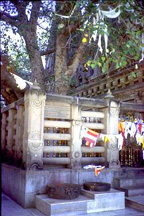 The Bo Tree on the western side of the Mahabodhi stupa. The 'elephant fence' was originally erected by Nagarjuna.
The Bo Tree on the western side of the Mahabodhi stupa. The 'elephant fence' was originally erected by Nagarjuna.
Khenchen Palden explained: 'This is the Indestructible Center. All things are impermanent, but here in Bodhgaya, in spite of all the changes, this Great Stupa has remained.'
The origins of the Mahabodhi temple/stupa are mythical. In 260 BC, King Asoka had built a small structure to commemorate the site. Later, it is said that the sons of a Brahmin family who lived in the area were arguing over who was supreme among all beings. Their mother finally suggested that instead of arguing, they would be better served by making a pilgrimage to Mount Kailasa and asking Mahadeva himself for the answer. So they made their way up into the hills, following the Ganga to its headwaters. There they met Mahadeva and put the question to him. Lord Shiva smiled, and gazing off into the sky, exhaled a cloud of blue smoke and gently said, "The Buddha is the teacher of the triple world. If you wish to plant a superior root of merit, then seek a superior field. The Bodhi tree is the place for attaining the fruit of a Buddha." He turned and looked directly at the boys, raised an eyebrow and instructed them to return there and build a large monastery.
Not far from the stupa lived a very old woman who had actually been alive during the lifetime of the Buddha and had listened to him teach. She heard quite a bit about the marvelous and lifelike statue that was being created for the main hall of the Mahabodhi temple. Before it was installed and consecrated, she stopped by and took a peek, to see how accurate it was. Knowing that she had actually been in the Buddha's presence, the monks let her look. She was basically pleased, but indicated that there were some real differences. Concerned, the monks gathered closer to hear what she might say. "For example," she began, "the Buddha would speak the teachings in a clear voice and gesture gracefully, while this one, although very beautiful, is completely silent and sits without moving at all...."
In 1202, the Arabian Khilji and his troops destroyed the shrine at Bodhgaya. By the end of the century, all the monasteries were gone. For the next six centuries there were virtually no Buddhists in the area. Near the end of the sixteenth century, devotees of Shiva resettled around the ruins and the Muslim government supposedly granted the site to them. In the middle of the nineteenth century a group of Burmese Buddhists came to restore the main shrine. With help from the Government of India, this work was finished in 1880. As Buddhists began to move back in, the Mahant took steps to insure that the site would remain Hindu. The Buddha image in the Mahabodhi Temple was transformed into a Hindu deity. A small Saivite sanctuary was constructed immediately east of the main shrine, and temple images were removed from their original niches to be placed within it. An Englishman named Sir Edwin Arnold happened to pass through and upon seeing this, began appealing to the British Government to transfer care of the site to the Buddhists. They never did. For over fifty years, there was an ongoing dispute between Buddhists and the Saivite Mahant. India became independent in 1945 and officially recognized Bodhgaya as a Buddhist holy site in 1949. Even today, the presence of the Brahmins in the Mahabodhi compound can provide the unsuspecting tourist with a rather awkward experience.
Leaving the market on the main street, one moves through throngs of beggars lining the walkway into the main compound. At the far end there is a concrete shed where you can leave your shoes and take a number. Entering the eastern gates one walks down stairs facing the monument to Great Awakening. At this point, I was traveling alone, without the Khenpos or anyone in the group. I spent hours each day walking around the stupa, on the circumambulation routes. A Tibetan in robes who had seen me go by a number of times one morning made of point of stopping, and getting my attention. "It is good you are here," he began, in perfect English. "The Mahabodhi stupa is a very important place and there are many beautiful things to see in India. But while you are here, you should try to get some teachings. So many westerners come and end up being ordinary tourists while there are very precious opportunities to hear the Dharma taught by great masters, such as His Holiness the Dalai Lama." He proceeded to tell me about upcoming teachings in Dharmsala with 'good translators.'
I appreciated his concern and told him so.
Monks had taken many images and hid them in the bush when the Islamic invasions began. And the Phalgu had occasionally flooded its banks, sometimes burying the Diamond Throne itself under a few feet of silt, even when Bodhgaya was occupied by Buddhists. Pointing to a decaying mansion over by the riverbed, he continued, "An old Hindu Mahant used to live over there when I was a kid. He was a very powerful man and he always used to hang out around the (Mahabodhi) temple. He was trying to stay in control of the whole area. The first Buddhists that I remember coming here in any number were the Tibetans. That would have been in the early 1960's...."
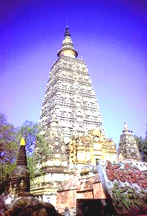 A large bell cast with Tibetan characters covering its surface hangs at the foot of the steps to the left, and beyond this is a row of three pink concrete shrine rooms which contain statues of the Buddha and his mother Queen Maya. But these are considered Hindu shrines, remnants of the old Saivite compound. As I entered I was greeted by a Brahmin who pointed to the statues, named them and said, "After the Buddha attained enlightenment, the first thing he did was offer flowers to the Devi who had instructed him to sit beneath the tree." At this, he picks up a freshly cut blossom and touches it to his head and places it before the shapely form of the Buddha's mother. Then he pushes the tray of flowers towards me, indicating that I am to do the same. "You may offer flowers to the Buddha and his mother." So I take one and place it before the Buddha. The priest offers me a ceremonial scarf, saying, "Here, offer this kata to Mayadevi." So I did. Then he whispers, "A small donation would be appropriate." I reached in my pocket and was about to drop some rupees in a rusty locked box that was chained to the floor when he came up behind me and said, "NO! Do not put it in there!" Then, hurriedly composing himself and adjusting his robe, he attempted a smile and added, "You can just leave it on the Buddha's lap....."
A large bell cast with Tibetan characters covering its surface hangs at the foot of the steps to the left, and beyond this is a row of three pink concrete shrine rooms which contain statues of the Buddha and his mother Queen Maya. But these are considered Hindu shrines, remnants of the old Saivite compound. As I entered I was greeted by a Brahmin who pointed to the statues, named them and said, "After the Buddha attained enlightenment, the first thing he did was offer flowers to the Devi who had instructed him to sit beneath the tree." At this, he picks up a freshly cut blossom and touches it to his head and places it before the shapely form of the Buddha's mother. Then he pushes the tray of flowers towards me, indicating that I am to do the same. "You may offer flowers to the Buddha and his mother." So I take one and place it before the Buddha. The priest offers me a ceremonial scarf, saying, "Here, offer this kata to Mayadevi." So I did. Then he whispers, "A small donation would be appropriate." I reached in my pocket and was about to drop some rupees in a rusty locked box that was chained to the floor when he came up behind me and said, "NO! Do not put it in there!" Then, hurriedly composing himself and adjusting his robe, he attempted a smile and added, "You can just leave it on the Buddha's lap....."
I dropped the coins in the box, looked up at the angry priest for a second and left the room.
Kali yuga...
The Mahabodhi Stupa from the eastern side.
The pink buildings at the foot of the stupa are Hindu shrines.
When the degenerate age of this aeon arrives,
people are their own deceivers, their own bad counsel,
the makers of their own stupidity, lying to and fooling themselves.
How sad that these people have human forms but possess no more sense than an ox!
-Padmasambhava
I do another few circles around the stupa as someone recites prayers over a PA system. A group of monks from southern India is wrapping a monk's robe around the trunk of the Bo Tree, while others are busy sweeping. A young Tibetan has set up on the north side of the stupa with a cloth and stick contraption before him to catch the bejewelled rice from his mandala practice. He seems to be enjoying himself. A few monks and a westerner are going at it on the prostration boards. I pass the little stupa where you burn a little snippet of your hair and sit down on a concrete slab which seems to host an image of Ganesh and figures from the Ramayana in dark stone. I am soon joined by a young man in a denim jacket named Amir. He speaks good English and is very polite and friendly. Originally from Lucknow, Amir is a school teacher who lives in Calcutta and is here in Bodhgaya on pilgrimage. As he goes on, I realize that I am talking to a very intelligent, radical Muslim. He began to educate me about the caste system, Brahmanism, Indira Gandhi and the action against the Sikh radicals in the Golden Temple, all the way back to the days of Gandhi, Nehru and Jinna. I listened to him for about an hour and enjoyed his company. As he spoke, I began to feel that in many ways, we were both outsiders. The Hindus are a very old tribe. I laughed when he warned me about the Brahmin priest on the east side of the compound and told him we'd already met. As we parted, he gave me his address and urged me to study the writings of Ambedkar. I immediately head over to the Mahabodhi bookstore and ask a rather large monk if he has anything by Ambedkar. He smiles and points me to a small publication entitled "The Annihilation of Caste". I buy it and walk over to The Green Onion, looking through it while waiting to be served a bowl of tuk-pa.
Ambedkar was born among "untouchables" in 1891. After attending Columbia University in New York through the patronage of a maharaj, he practiced law in Bombay where he became active in nationalist politics as a champion of the Harijans and was elected to public office. After independence from Britain, he became Minister of Law in India's first post - independence government. Ambedkar drafted the national constitution, adopted in 1949, which provided the legal framework for the abolition of many oppressive features of Indian society and gained rights for India's 60,000,000 untouchables. He resigned from the government over differences with Nehru in 1951. In October 1956, Ambedkar converted to Buddhism and led 400,000 Untouchables to do the same. More mass conversions happened in the subsequent months.
"On the other hand we can say that generally speaking History bears out the proposition that political revolutions have always been preceded by social and religious revolutions. The religious Reformation started by Luther was the precursor of the political emancipation of the European people. In England Puritanism led to the establishment of political liberty. Puritanism founded the new world. It was Puritanism which won the war of American Independence and Puritanism was a religious movement. The same is true of the Muslim Empire. Before the Arabs became a political power they had undergone a thorough religious revolution started by the Prophet Mohammad. Even Indian History supports the same conclusion. The political revolution led by Chandragupta was preceded by the religious and social revolution of Buddha. The political revolution led by Shivaji was preceded by the religious and social revolution led by Guru Nanak. It is unnecessary to add more illustrations. These will suffice to show that the emancipation of the mind and the soul is a necessary preliminary for the political expansion of the people."
-Dr. Bhimrao Ramji Ambedkar
After a quick dinner, I bought a few dzi beads, traded my mini-calculator for some of the best Tibetan incense ever, and bought a few postcards before heading back toward the center of the universe.
Source used for quote:
Advice from the Lotus Born A Collection of Padmasambhava's Advice to the Dakini Yeshe Tsogyal and Other Close Disciples translated by Erik Pema Kunzang, edited by Marcia Binder Schmidt, Rangjung Yeshe Publcations, 1994.
Annihilation of Caste by Baba Saheb B.R. Ambedkar, 14th edition, Anand Sahitya Sadan, 1989
18-Feb-2000
More by : Shiloh